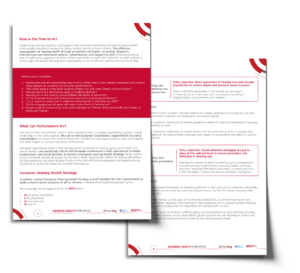
Hearing Loss in Europe: A Growing Challenge
-
- There are 196 million people living with hearing loss in Europe
-
- Around the world over 1,5 billion people live with hearing loss – this will rise to 2.5 billion people by 2050
-
- Reduced quality of life (QoL) costs Europe €67 billion per year
-
- The EU loses €149 billion from reduced productivity, under-employment, or unemployment of adults living with untreated hearing loss
-
- Around 20% of women and 30% of men in Europe will live with hearing loss by the age of 70. (Shield, 2019, WHO, 2021; Lamb et al, 2016, hear-it, 2019)
Learn more about hearing loss and cognitive decline in adults.
Hearing Loss Requires Immediate Action
Hearing loss doesn’t just affect individuals—it impacts families, friends, and communities. Left untreated, hearing loss can isolate a person, cutting off their connection to loved ones and the world around them.
Through targeted efforts to raise awareness, ensure early detection and prevention, expand access to care, and invest in research and data collection, we can significantly reduce the impact of hearing loss on millions of lives. Treating hearing loss not only improves individual well-being but also has measurable health benefits, such as reducing the risk of dementia by over 8%. For children, addressing hearing loss early can greatly enhance their speech and language development, educational success, and future career opportunities.
These outcomes can only be achieved with the right policies in place. That’s why we’re advocating to make hearing health a priority on national and European political agendas.Join our efforts by signing the Policy Manifesto on Hearing Health.

















